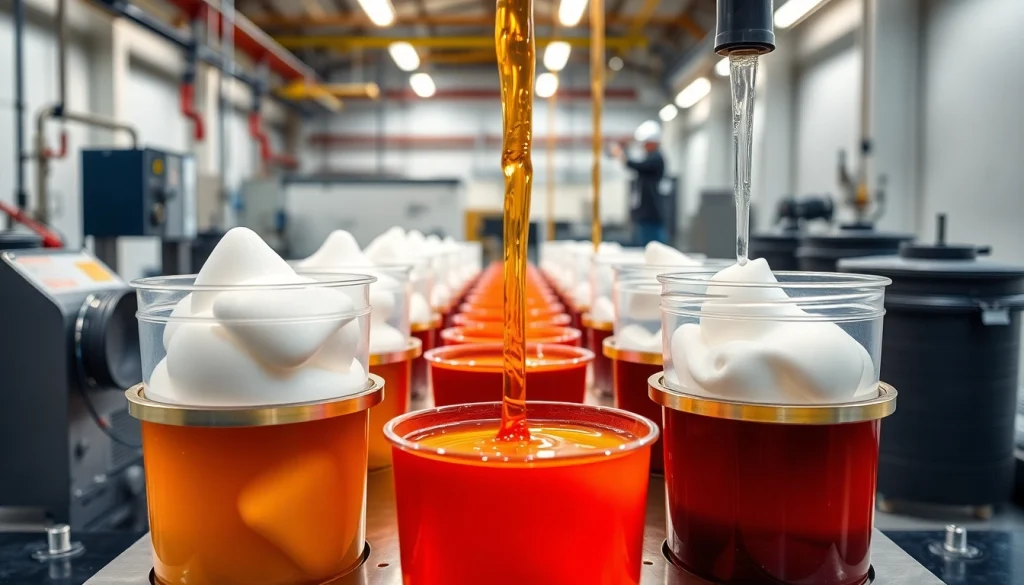Understanding Infusion Resins
Infusion resins have become a critical component in advanced composite manufacturing, appealing to industries that demand high performance and durability. These specialized resins are engineered to be low-viscosity materials, allowing them to flow easily into complex molds and composite structures. Infusion resins facilitate the creation of lightweight yet strong components, making them ideal for applications in aerospace, automotive, marine, and construction sectors.
What are Infusion Resins?
Infusion resins are thermosetting resins typically used in vacuum infusion processes. During this process, air is evacuated from a mold containing dry reinforcement materials, allowing the low-viscosity resin to be drawn into the mold by atmospheric pressure. This ensures a high fiber-to-resin ratio, promoting superior part strength and a reduction in waste material.
There are different types of infusion resins, with epoxies and polyesters being the most common. Each offers distinct advantages, including thermal stability, chemical resistance, and ease of use, depending on the specific requirements of the manufacturing process and the final application of the composite part.
Components of Infusion Resins
The typical composition of infusion resins includes a resin base, hardener, and various additives to enhance performance. The resin base serves as the primary matrix providing structural integrity, while the hardener initiates the chemical reaction that cures the resin. Additives can improve the flow characteristics, control viscosity, enhance adhesion properties, or increase the resistance to environmental factors.
Some key components include:
- Ester-based resins: Known for their affordability and broad application range.
- Epoxy resins: Offer superior mechanical properties and are often used in high-performance applications.
- Accelerators and inhibitors: Control the curing time and process to suit specific manufacturing conditions.
How Infusion Resins Work
The infusion process begins with the preparation of the mold, where reinforcement materials such as fiberglass, carbon fiber, or aramid fibers are laid out. Once the materials are positioned, the mold is sealed, and a vacuum is applied to remove any trapped air and moisture. The low-viscosity resin is then introduced, typically through a series of strategically placed ports in the mold, allowing for a uniform distribution and saturation of the fibers.
This technique minimizes voids and other defects, resulting in high-quality composite parts that exhibit excellent mechanical and physical properties. The curing phase follows, where the resin hardens and solidifies, often at room temperature but also through the application of heat in some systems.
Applications of Infusion Resins
The versatility of infusion resins allows them to be employed across a wide range of industries. Their strength, efficiency, and design flexibility make them particularly favorable for products that require high performance under challenging conditions.
Industry Uses of Infusion Resins
Infusion resins are widely used in several industries, including:
- Aerospace: Used in the fabrication of lightweight composite structures such as aircraft wings and fuselages.
- Automotive: Manufacturers utilize infusion resins for creating lightweight components that enhance vehicle performance and fuel efficiency.
- Marine: Infusion resins are increasingly replaced by traditional hand lay-up methods in boat manufacturing, ensuring stronger and more durable hulls.
- Construction: Employed for structural components, such as beams and columns, where high strength and low weight are critical.
Benefits of Using Infusion Resins in Manufacturing
The adoption of infusion resins in manufacturing provides numerous benefits:
- Enhanced Strength-to-Weight Ratio: Infusion resins allow for the creation of lightweight composites without compromising strength.
- Reduced Waste: The vacuum process minimizes excess resin and materials, leading to more sustainable practices.
- Improved Finish: Infusion resins provide a superior surface finish compared to traditional methods, reducing the need for post-processing work.
- Versatility: These resins can be tailored to meet specific mechanical, thermal, and aesthetic requirements for various applications.
Case Studies of Successful Infusion Resins Implementation
Several organizations have successfully adopted infusion resins to improve production efficiency and product performance. For instance, an automotive manufacturer transformed their assembly line by incorporating infusion resins, significantly decreasing weight without sacrificing structural integrity, ultimately leading to better fuel efficiency and improved vehicle performance. Another case highlights a marine company that used infusion resins to manufacture composite hulls that demonstrated enhanced resistance to environmental factors like saltwater and UV exposure, increasing lifespan and reliability.
Choosing the Right Infusion Resins
When selecting infusion resins for specific applications, manufacturers must consider a variety of factors to ensure optimum performance.
Key Factors to Consider
Some of the key parameters to evaluate when choosing infusion resins include:
- Viscosity: Lower viscosity resins are preferable for complex geometries as they flow more easily into molds.
- Curing Time: Depending on production schedules, the choice of resin with the appropriate curing time is crucial.
- Mechanical Properties: Assess the required tensile strength, flexural modulus, and impact resistance based on application demands.
- Compatibility: Ensure that the selected resin is compatible with reinforcement materials and the manufacturing process.
Infusion Resins vs Other Resin Types
Infusion resins differ primarily from other types of resins, such as hand lay-up or spray-up resins, in terms of flow characteristics, waste reduction, and finished product quality. Infusion resins, especially epoxy varieties, often provide superior mechanical properties due to their better adhesion and distribution into the fibers.
Choosing the right resin type is essential as each possesses unique characteristics that confer advantages in particular applications. For instance, while infusion resins may be favored for high-performance applications, polyester resins could be chosen due to their lower costs for less demanding uses.
Common Challenges and Solutions
Working with infusion resins may present several challenges:
- Ensuring Complete Wet-out: It is critical to ensure complete saturation of the reinforcements. This can be achieved by optimizing the vacuum pressure and resin infusion rates.
- Risks of Voids: When not properly managed, voids may appear in the finished part. Utilizing advanced monitoring methods during the infusion can help mitigate this risk.
- Curing Issues: Temperature control is essential for proper curing. Using preheating techniques or heated molds can enhance curing efficiency for large parts.
Best Practices for Working with Infusion Resins
Embracing best practices in the use of infusion resins can significantly influence production outcomes and quality. Establishing a reliable workflow ensures efficiency in the infusion process and overall part performance.
Preparation and Handling of Infusion Resins
Prior to using infusion resins, thorough preparation is essential:
- Mold Preparation: Ensure that the mold is clean and properly treated with release agents to facilitate easy part removal.
- Mixing Ratio: Follow precise mixing ratios as specified to achieve optimal properties and avoid curing issues.
- Temperature Control: Store the resin and hardener at the recommended temperatures before mixing for consistent results.
Techniques for Successful Infusion Processes
The infusion process can be optimized through various techniques:
- Strategic Port Placement: Positioning resin inlet and vacuum ports correctly in the mold can maximize airflow and resin distribution.
- Vacuum Integrity: Maintaining vacuum integrity throughout the process prevents air entrapment and void formation.
- Monitor Flow Rate: Adjust the infusion rate based on the viscosity and complexity of the mold to ensure an even fill.
Maintenance and Storage Recommendations
Proper maintenance and storage of infusion resins can significantly improve their shelf life and usefulness:
- Storage Conditions: Store resin components in a cool, dry location to minimize degradation over time.
- Expiration Monitoring: Always check the expiration dates and use resins before they expire for reliable performance.
- Environment Control: Monitor the working environment for humidity and temperature, especially during mixing and application, to ensure optimal curing.
Future Trends in Infusion Resins
As technologies and manufacturing processes evolve, infusion resins are expected to play a crucial role in future innovations. With increasing emphasis on sustainability, performance, and efficiency, the following trends are anticipated:
Technological Advances in Infusion Resins
Advancements in resin chemistry are fostering the development of infusion resins with enhanced properties. Innovations such as bio-resins and hybrid systems are being explored to offer more sustainable alternatives that maintain mechanical integrity while reducing carbon footprints. Furthermore, improvements in automated infusion systems are leading to greater precision and reproducibility in the manufacturing process.
Sustainability and Eco-friendly Initiatives
With a growing focus on environmental preservation, many manufacturers are developing eco-friendly infusion resins derived from renewable sources. These innovations not only reduce reliance on fossil fuels but also enhance the recyclability of composite materials. The industry is likely to witness a rise in biodegradable reinforcement options that complement the eco-friendly resin systems.
The Future Landscape of Infusion Resins in Industry
As industries adapt to new challenges, infusion resins are poised to become increasingly integral in both established and emerging markets. Their potential application in advanced sectors like renewable energy and electric vehicles—where weight reduction and performance optimization are paramount—will continue to drive innovation and demand for high-quality infusion resins. The ongoing research and development into customizing and enhancing resin formulations will further align product performance with market needs and environmental considerations.





